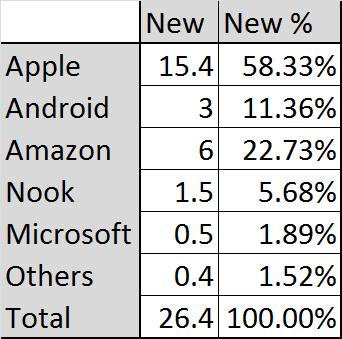If you look at the image above, you might come to the conclusion that Android tablets have made significant inroads against the iPad in the fourth quarter of 2011.
That would be an incorrect conclusion, though one that many people are making.
There are two problems with the conclusion. The first is that while Apple discloses ‘sales’, Android numbers are a combination of ‘shipments’, ‘% shipment increase from last year’, and ‘estimates’. In other words, real numbers against imaginary numbers. More on this later.
The other problem is the idea of exactly what constitutes an Android tablet. I’ll answer with a question … was the HP200LX considered a ‘computer’? No, in spite of running DOS 5, sporting an x86 processor and allowing for installation of programs, it was seen as a PDA. And an awesome one. But the point is that in spite of sharing some characteristics, they are just not the same beast.
The same is true when comparing so-called Android tablets.
Is anything in a bigger-than-phone size with the Android OS at its’ core an Android tablet? Certainly that is an argument, but I would instead turn the criteria that Google uses on manufacturers around on them: if there is no Android Market, no Google services … it is NOT an Android tablet. It is an ‘Android-based device’ to be sure … just like the HP200LX was a PC.
So what does that mean? It means that I would not categorize the Kindle Fire or the Nook Color/Tablet as Android tablets. Their core focus in on the vertical integration of the content offered by Amazon & Barnes & Noble, NOT Google.
So what happens if we assume that Amazon sold 6 million Kindle Fire units in the fourth quarter, and that Barnes & Noble sold the 1.5 million Nook Color/Tablet units they ordered, what would the picture look like? Here is a modified table assuming the same 26.4 million total.
So we see that Amazon and Barnes & Noble would account for more than 27% of tablet share in the fourth quarter, with Android tablets accounting for less than 12%. Not only is that a HUGE decrease in market share year on year, it actually shows a VOLUME decrease! We can debate the Nook Color figures in 2010 versus 2011 … but in general it shows what I have said all along – there is a general consumer rejection of Android Tablets.
Let me say it again: MOST (87%) people DO NOT WANT an Android Tablet – they WANT an iPad, an Amazon tablet or a Barnes & Noble tablet.
Before I questioned the shipment numbers for Android. Why? Well, in specific I look at Samsung. Last year there was talk of 1-2 million Galaxy Tabs shipped in Q4 2010 which were then counted as sales – when we later found to be MUCH less than 100,000! Not only that, but the Android tablet return rate has repeatedly been shown to exceed even the very high return numbers of Android phones … which compares to the ~2% iOS returns.
And this year Samsung stopped reporting actual numbers and only reports deltas from prior year ‘for competitive reasons’. Aside from calling BS on that in general, I see it as a clever ‘out’ for Samsung to avoid discussing numbers in general, leaving speculation to analysts … which always benefits and never hurts Samsung! So if Samsung was pegged at 1.5 million tablets for 2010 and reported a 66% increase for 2011, then analysts would report 2.5 million in sales as FACT. So once again we are dealing with Apple’s actual 15.4 versus some phantom estimate from analysts regarding Samsung.
Finally – look at the most iconic Android tablets of the last year. We have the Xoom (failure), Galaxy Tab 10.1 (globally found to be a shameless iPad clone), HTC Flyer (key feature is a stylus … but it required a $89 stylus bought separately – which no one did), and a bunch of other generic and mediocre tablets no one remembers. And … the ASUS Transformer (and now Transformer Prime). One of the very best selling and most unique Android devices of the past year, quickly getting the Ice Cream Sandwich update, and iconic because of the keyboard dock with trackpad and battery extender (albeit for $150 more).
So let me correct the story, the story is NOT about Android market share … in fact, here are the tablet news headlines for 2011:
– 2011 was the year of the iPad 2, as reflected by massive sales, monstrous enterprise penetration, and complete domination of markets such as music production and gaming.
– 2011 saw the first credible tablet alternative in the Kindle Fire, which rose from nowhere to 22% of the market. The Nook also increased sales considerably.
– The total story for 2011 tells that the market is looking for a vertically integrated solution, not a fragmented device with a sub-standard OS and mediocre support.
– The Android story for the year is that the most iconic and one of the top selling devices of the year was … basically a netbook.

